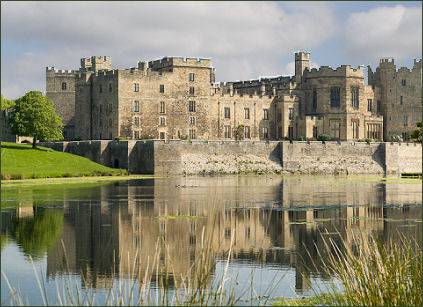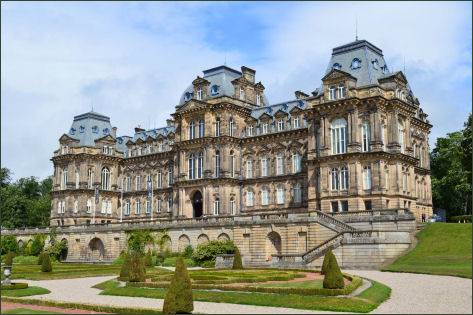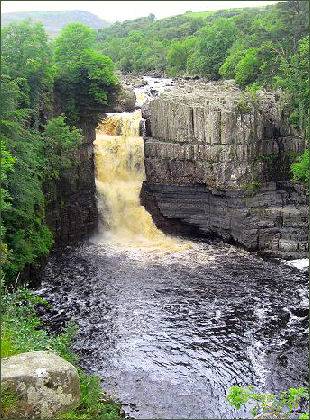Teesdale
 Beautiful Teesdale on the east side of the Pennines in County Durham, was historically once part of Yorkshire.
Beautiful Teesdale on the east side of the Pennines in County Durham, was historically once part of Yorkshire.
. Large parts of Teesdale fall within the North Pennines Area of Outstanding Natural Beauty (AONB) - the second largest AONB in England and Wales. The River Tees rises below Cross Fell, the highest hill (2,930 feet O.D.) in the Pennines, and its uppermost valley is remote and high.
Teesdale's most populous settlement is Barnard Castle, a market town and a popular tourist destination. The town centre of Barnard Castle, known locally as 'Barney', has many old cobbled streets and characterful twisting lanes which are lined with buildings from the Georgian and Victorian eras. There are many pubs, clubs, Bed and breakfast establishments, hotels, shops and restaurants. Barnard Castle is an excellent shopping centre and boasts several antique shops, many of the town's shops are thriving independent retailers. There are shops selling home décor, second-hand books, designer clothes, jewellery, accessories, vintage and retro items, local crafts, gifts and much more. The Witham arts centre hosts an events programme of music, theatre, film and comedy.
The town derives its name from the castle which it developed around. Historic and imposing Barnard Castle (pictured left) was constructed on the site of an earlier defended position from around 1095 to 1125 by Guy de Balliol, a Norman baron originating from Bailleul-en-Vimeu close to Abbeville in Northern France, who was granted land in northern England in the late eleventh-century.
 The town is also home to the renowned Bowes Museum, which holds internationally important collections and is is housed in a French chateau style building . The museum was constructed as a public art gallery by John Bowes and his wife Joséphine Chevalier, Countess of Montalbo. Bowes, a wealthy coal magnate and horse breeder with a passion for the arts, was the illegitimate son of John Bowes the 10th Earl of Strathmore, and Kinghorne. The Bowes Museum covers European fine and decorative arts from the medieval period to the twentieth century.
The town is also home to the renowned Bowes Museum, which holds internationally important collections and is is housed in a French chateau style building . The museum was constructed as a public art gallery by John Bowes and his wife Joséphine Chevalier, Countess of Montalbo. Bowes, a wealthy coal magnate and horse breeder with a passion for the arts, was the illegitimate son of John Bowes the 10th Earl of Strathmore, and Kinghorne. The Bowes Museum covers European fine and decorative arts from the medieval period to the twentieth century.
Dramatic Raby Castle, one of England's finest medieval castles, is situated near the village of Staindrop. The castle was built around 1367-1390 by John Neville, 3rd Baron Neville of Raby and is believed to occupy the site of a palace built by King Canute. This Norse connection is reflected in the name Raby, which derives from 'Ra' meaning a boundary and 'Bi', a settlement.
Teesdale also includes the small town of Middleton-in-Teesdale, a few miles to the northwest of Barnard Castle, it was once a lead-mining centre, and plentiful traces of this industry can be seen round the adjoining slopes and side-valleys. On the south side of Teesdale looms the Bronze Age burial site of Kirkcarrion. The settlement is surrounded by the North Pennines Area of Outstanding Natural Beauty (AONB) and is located on the Pennine Way about nine miles from High Force, an impressive waterfall on the upper course of the river Tees.
The gorge at High Force (below right) has been shaped by the action of water, from the torrential meltwaters released at the end of the last ice age, to today's River Tees. The hard rock of the Whin Sill forms a resistant lip over which the river plunges. Over thousands of years the water erodes away the softer sandstone and limestone lower in the cliff, undercutting the Whin Sill.
 Low Force is also situated on the River Tees, and lies within the North Pennines Area of Outstanding Natural Beauty (AONB).
The waterfall, which was once known as Salmon Leap, consists of an impresive eighteen feet (5.5 metres) high set of falls, further upstream is its larger sister, the spectacular High Force waterfall.
Low Force is also situated on the River Tees, and lies within the North Pennines Area of Outstanding Natural Beauty (AONB).
The waterfall, which was once known as Salmon Leap, consists of an impresive eighteen feet (5.5 metres) high set of falls, further upstream is its larger sister, the spectacular High Force waterfall.
The Bowlees Visitor Centre, near Newbiggin in Teesdale provides an excellent base for exploring the beautiful Upper Teesdale valley and provides footpath links to the impressive waterfalls of Low Force and its sister High Force, and Newbiggin and the Pennine Way. The North Pennines Area of Outstanding Natural Beauty (AONB) Partnership restored and reopened the centre in a former Methodist chapel in June 2013. It offers information and interesting displays on the geology and landscape, the wildlife and people of Upper Teesdale and the wider North Pennines.
Remote Cow Green Reservoir in Upper Teesdale measures 2 miles (3 km) long and was constructed between 1967 and 1971 for the Tees Valley and Cleveland Water Board mainly to supply water to the industries around the Tees Estuary and Darlington. Moor House-Upper Teesdale National Nature Reserve in 1969, from what was previously two separate nature reserves and is England's largest such reserve. It contains the unique Teesdale Violet and the blue Spring Gentian as well as more common Pennine flowers such as rockrose, spring sandwort, mountain pansy, bird's-eye primrose and butterwort.
A short distance downstream from the dam is Cauldron Snout waterfall, situated well upstream of the High Force waterfall, It is more a long cataract than a waterfall, caused by the upper Tees passing over dolerite steps of the Whin Sill. At 200 yards (180 metres) long, it is considered to be the longest waterfall in England. It is impressive by the scale of the British landscape, and attracts a lot of visitors, despite the 3-kilometre (1.9 mile) walk from the nearest car park at Cow Green Reservoir. The Pennine Way takes in Cauldron Snout.
Hannah's Meadow is a Site of Special Scientific Interest in the heart of the North Pennines Area of Outstanding Natural Beauty (A.O.N.B), which comprises of one of the most extensive and remote areas of upland England. Hannah's Meadow consists of three fields, located at Low Birk Hatt Farm, on the north side of Blackton Reservoir, in Baldersdale, some 7 km west of the village of Cotherstone. The site is named after Hannah Hauxwell, who lived alone at Low Birk Hat Farm whose farm it was for over fifty years.
Egglestone Abbey, or the abbey of St Mary and St John the Baptist, a former Premonstratensian Abbey is situated on the scenic and peaceful southern bank of the River Tees, just over a mile to the south-east of Barnard Castle. The Abbey was founded on land granted by the de Moulton family between 1168 and 1198. The Premonstratensian order was founded by St Norbert at Prémontré in France in 1121, the monks wore a white habit and were known as the White Canons.
Situated near Barnard Castle and set set in the beautiful high Pennines of Teesdale, Eggleston Hall Gardens are aptly described as 'The Secret Garden of the North'. The stunning gardens encompass four acres and include a nursery.
